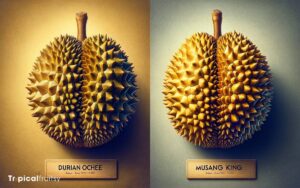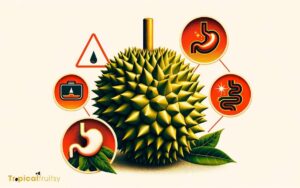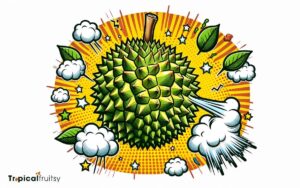Puyat Durian Vs Musang King: Which is Best!
The Puyat and Musang King durians are two popular cultivars that offer unique taste profiles and textures.
The Puyat variety, hailing from the Philippines, is known for its distinct flavor, while Malaysia’s Musang King is celebrated for its creamy texture and rich taste.
Understanding the differences between these two varieties is essential for durian enthusiasts and professionals in the fruit industry.
The Puyat Durian and Musang King are distinct in several ways:
A comparison of their specific characteristics can help consumers make informed choices and appreciate the nuances of these exotic fruits.
Discover the exotic flavors of Puyat and Musang King durians, each offering a unique sensory journey.
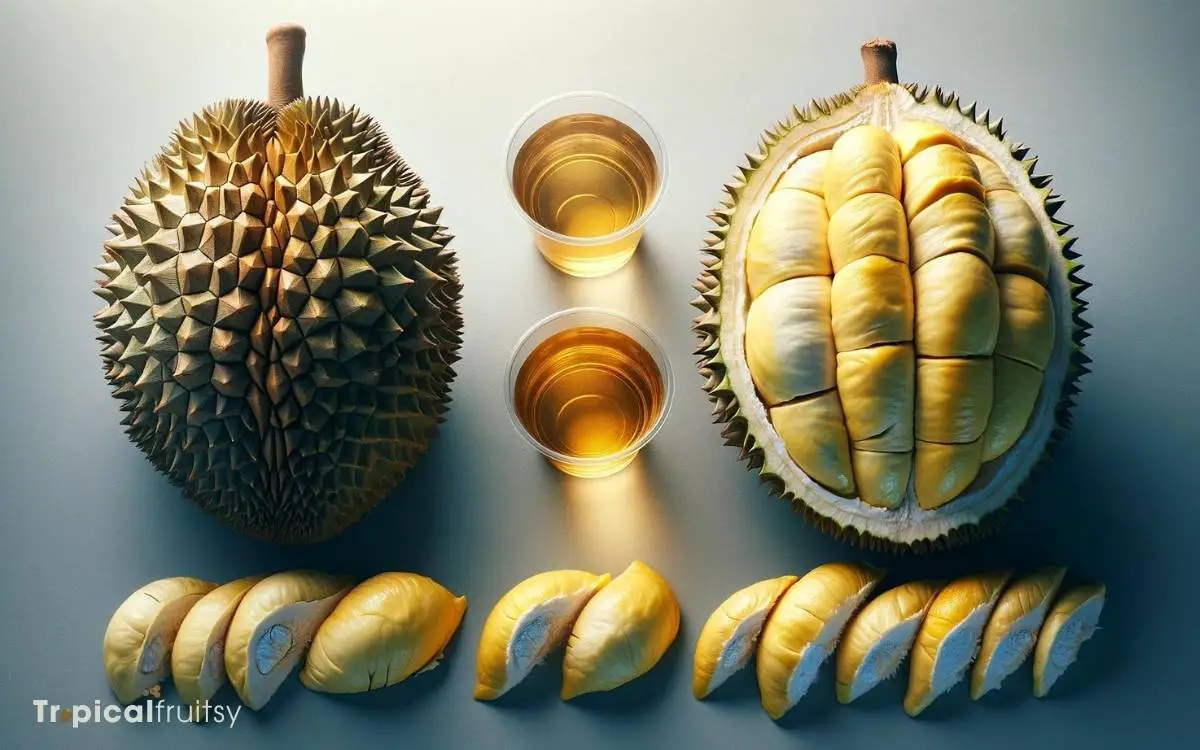
Key Takeaway
Puyat Durian vs Musang King: A Comprehensive Comparison
| Feature | Puyat Durian | Musang King Durian |
|---|---|---|
| Origin | Philippines | Malaysia |
| Color | Varies, typically pale yellow | Vibrant yellow |
| Taste | Distinct, less intense than Musang King | Rich, sweet, with a hint of bitterness |
| Texture | Creamy to slightly firm | Consistently creamy and smooth |
| Seed Size | Large | Small to medium |
| Availability | Seasonal, less exported | Widely available, heavily exported |
| Price | Generally lower than Musang King | Premium, higher price point |
Origins and History
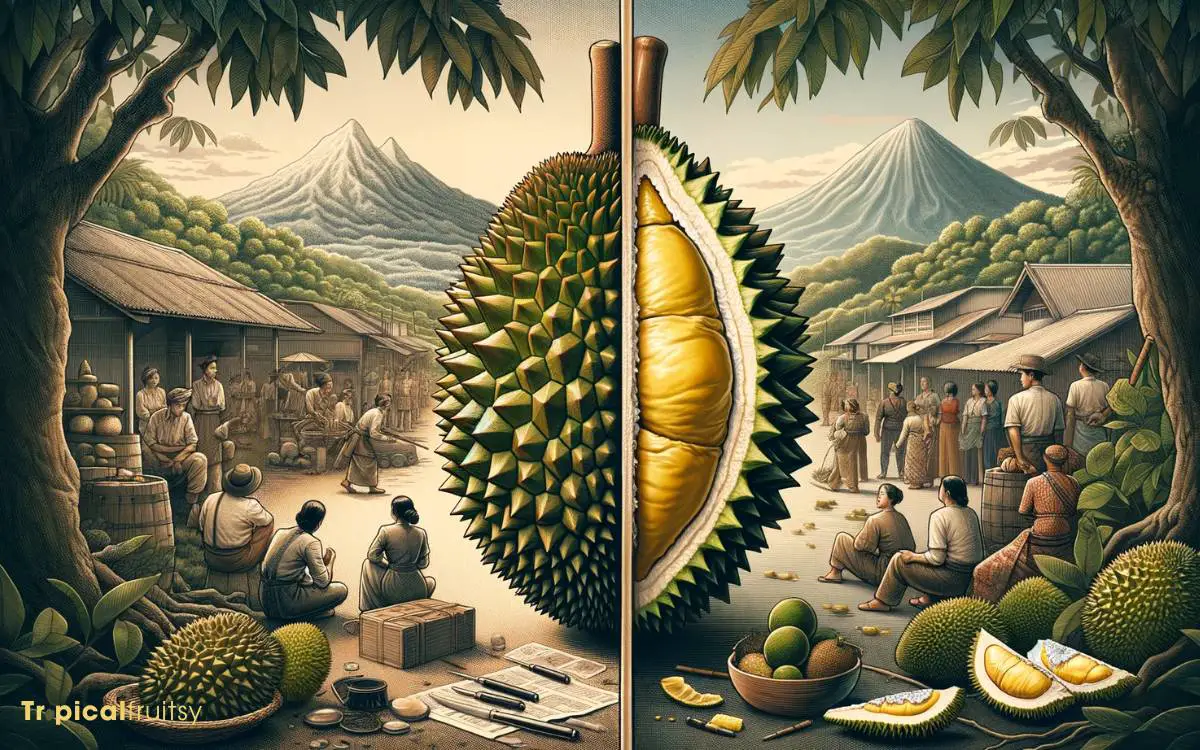
Where does the heritage of Puyat Durian and Musang King Durian originate, and how have these varieties established their reputations in the world of fruit?
The Puyat Durian hails from the Philippines, developed and popularized by the Puyat family. It is appreciated for its distinct sweetness and relatively mild odor compared to other durian types.
On the other hand, Musang King, also known as D197, traces its roots to Malaysia. It has gained international acclaim due to its creamy texture and intensely sweet, complex flavor profile, considered by many as the pinnacle of durian varieties.
Both fruits have leveraged their unique sensory attributes to carve out premium positions in the market, with Musang King often commanding higher prices and recognition, particularly in East Asian markets.
Physical Characteristics
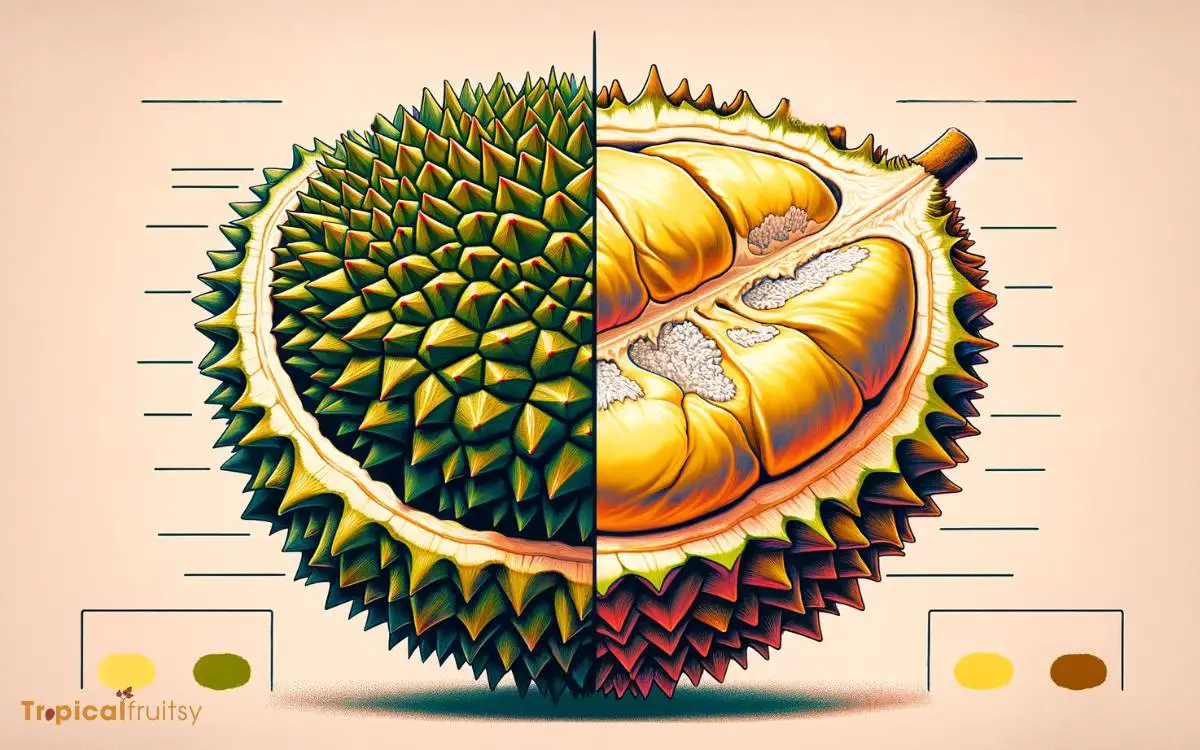
The Puyat Durian exhibits a more elongated shape and has fewer spikes, whereas the Musang King is recognized by its rounder, more uniform shape with a dense covering of short, stout spikes.
The physical attributes of each durian variety are not merely aesthetic but also serve as indicators of lineage and quality.
In an analysis of their physical characteristics, we can distinguish the following:
- The Puyat Durian’s spikes are longer and more spread out.
- Musang King’s thorns are renowned for their pyramid shape and sharpness.
- The color of Puyat’s husk often presents a lighter shade of green.
- Musang King features a distinctive star-like pattern at the base of the fruit.
Understanding these nuances is crucial for connoisseurs selecting premium durians.
Flavor Profiles Compared

We observe that the Puyat Durian offers a milder, somewhat bitter taste, in contrast to the Musang King’s intensely sweet and creamy flavor.
The Puyat variety, while still possessing the characteristic durian pungency, tends to have a more subdued sweetness that is often appreciated by those who favor complexity over intense sugariness.
Its bitterness is nuanced, adding depth to its profile without overwhelming the palate.
On the other hand, the Musang King is renowned for its rich, almost custard-like taste that carries a pronounced sweetness, complemented by subtle bitter notes which serve to enhance rather than detract from the overall experience.
The divergence in flavor profiles between the two is a testament to the diverse organoleptic qualities durians can possess.
Texture and Consistency
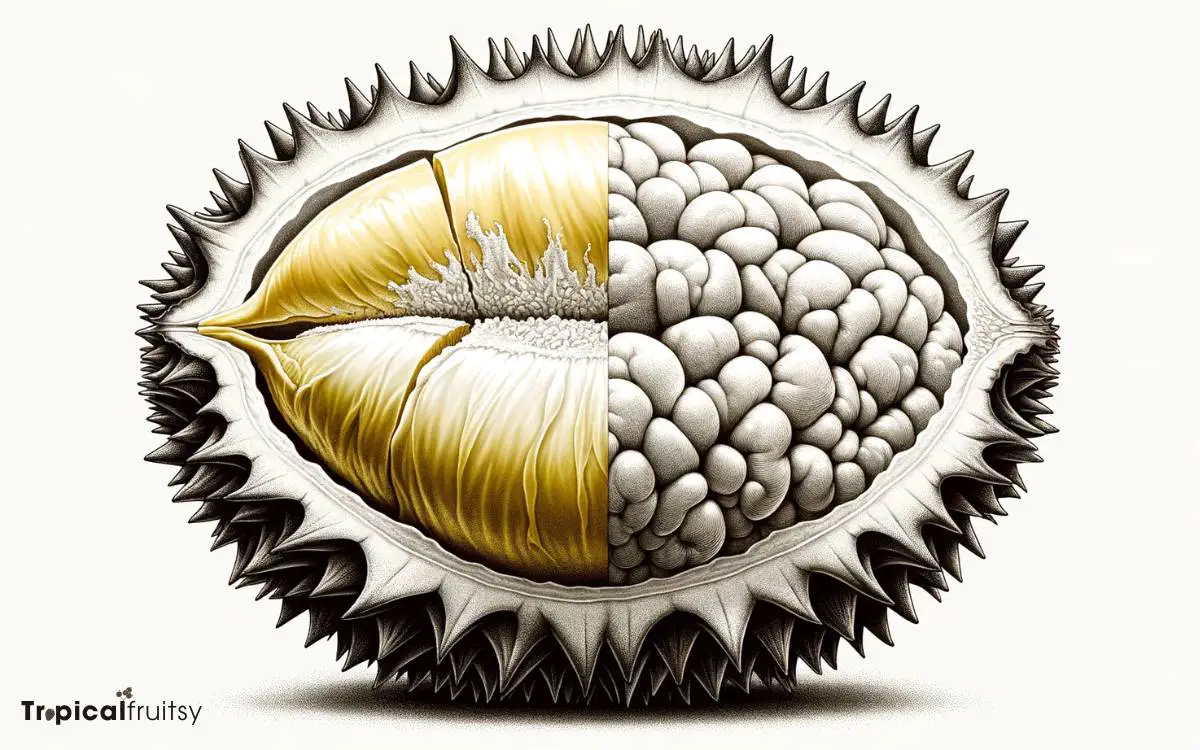
In assessing the textures of Puyat Durian and Musang King, one quickly notices the Puyat’s firmer flesh, which contrasts with the Musang King’s velvety, melt-in-your-mouth consistency.
The textural variations influence consumer preferences, with each variety appealing to different sensory expectations:
- Puyat Durian: Exhibits a denser, chewier texture, requiring a more deliberate consumption.
- Musang King: Renowned for its creamy, custard-like quality that dissolves effortlessly on the palate.
- Culinary Applications: Puyat’s robustness is better suited for recipes needing structural integrity, while Musang King’s smoothness enhances desserts.
- Ripeness Factor: Texture in both varieties can vary with ripeness; overripe fruits may become too soft, underscoring the importance of optimal harvest timing for desired consistency.
Nutritional Values
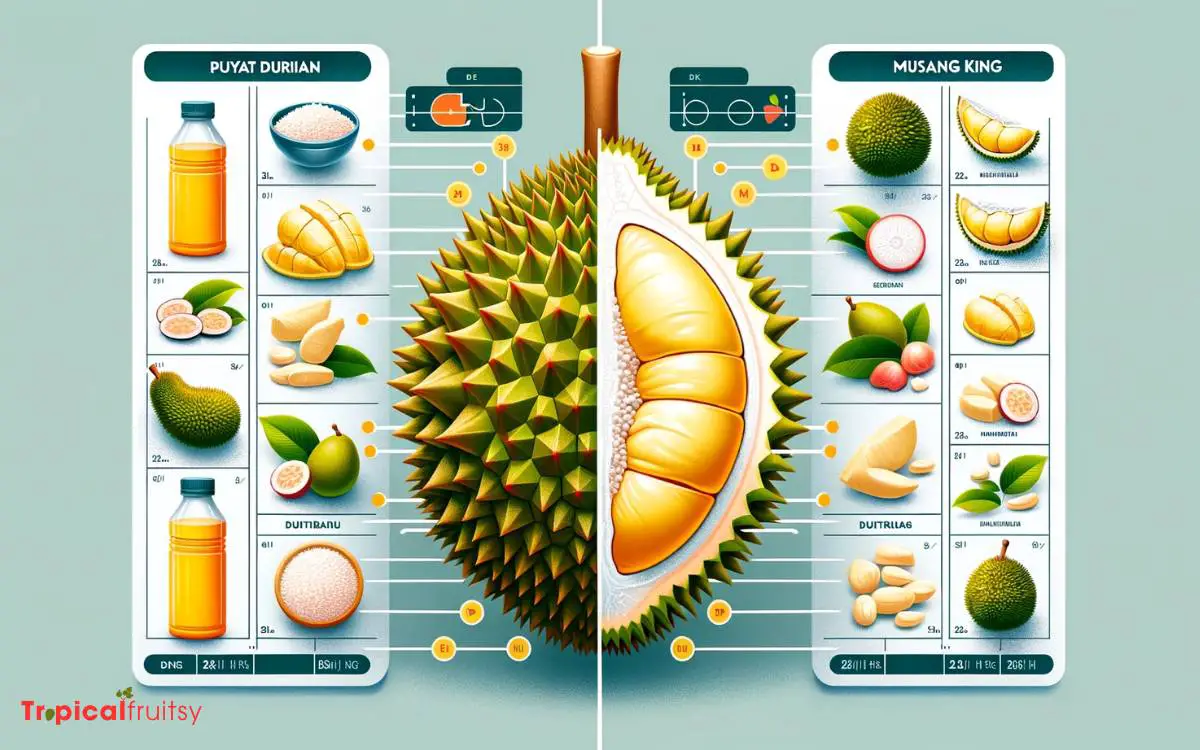
When comparing Puyat and Musang King durians, it is essential to scrutinize their caloric content to understand their impact on dietary energy intake.
The vitamin profile distinction between these two varieties may offer insights into their respective nutritional advantages, such as differences in vitamin C and A concentrations.
An analytical assessment of these parameters is vital for consumers making health-conscious choices and for producers considering breeding and cultivation strategies.
Caloric Content Comparison
Each variety of durian, including Puyat and Musang King, possesses a distinct caloric profile that reflects its nutritional value.
When comparing these fruits, it’s essential to analyze the caloric content to understand their impact on dietary intake.
Here is a nutritional breakdown:
- Puyat Durian: Typically contains approximately 147 calories per 100 grams, with a composition that prioritizes carbohydrates.
- Musang King: Renowned for its richness, it has around 165 calories per 100 grams, owing to its higher fat content.
- Dietary Fiber: Both varieties offer a good amount of fiber, which can affect net caloric absorption.
- Sugar Levels: The caloric content is also influenced by the natural sugars present, which can vary between seasons and ripeness.
These values are critical for individuals monitoring their caloric intake for weight management or health reasons.
Vitamin Profile Distinction
Beyond caloric content, Puyat and Musang King durians differ significantly in their vitamin profiles, which are essential for various bodily functions.
Puyat durians are distinguished by their noteworthy concentration of vitamin C, pivotal for immune defense and skin health, whereas Musang King durians are often highlighted for their rich levels of vitamin A, crucial for vision and cell growth.
Additionally, the B-complex vitamins, which play a vital role in energy metabolism, show variances between the two varieties, with Musang King generally offering a broader spectrum.
These distinctions underscore the importance of considering individual dietary needs when selecting between the two.
Cultivation and Availability

Several factors influence the cultivation and availability of Puyat Durian and Musang King, two highly sought-after varieties in the durian market.
A discerning analysis of these factors reveals a complex interplay between agronomic, climatic, and market-driven elements that determine their production and distribution.
Here are key considerations:
- Climate Conditions: Optimal growing conditions are paramount; Musang King requires specific temperature and humidity levels that are typically found in Malaysia, while Puyat thrives in the Philippines.
- Agronomic Practices: Advanced cultivation techniques, soil fertility management, and pest control are essential to maximize yield and quality.
- Harvesting Seasons: The availability of each variety is subject to its specific harvesting period, which can affect market presence and price.
- Market Demand: Global demand, particularly in China and Southeast Asia, significantly impacts the extent of cultivation and distribution logistics for these durian varieties.
Price and Market Demand
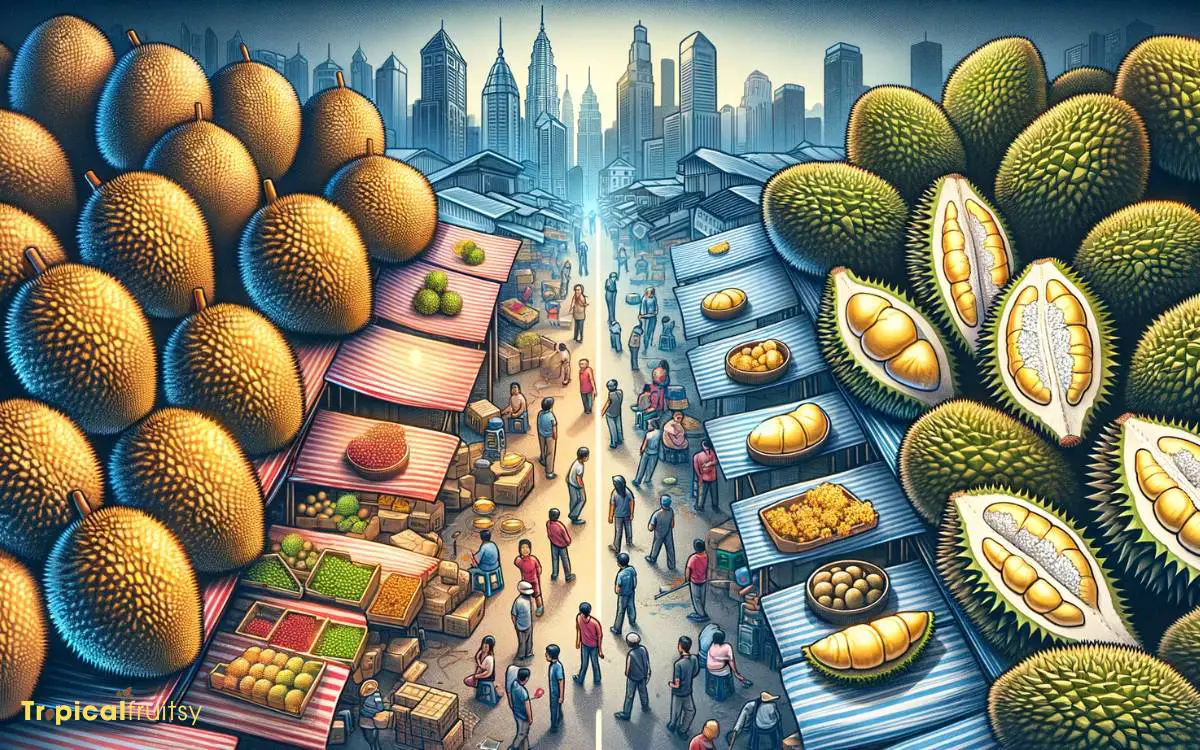
The price and market demand for Puyat Durian and Musang King vary significantly due to their distinct flavor profiles and regional preferences.
The Musang King, hailed as the king of durians, often commands a higher price point in the market, reflecting its coveted status among durian aficionados.
The Puyat, on the other hand, is typically more affordable, appealing to a different segment of consumers who favor its unique taste and lower cost.
Analyzing the market trends, Musang King has consistently shown robust demand, which translates to its premium pricing.
In contrast, Puyat Durian caters to a more price-sensitive market, resulting in a lower price but with a demand that cannot be underestimated.
| Durian Variety | Emotional Trigger for Demand |
|---|---|
| Musang King | Exclusivity and Prestige |
| Puyat | Accessibility and Value |
Conclusion
In summary, Puyat Durian and Musang King represent the diverse tapestry of durian cultivars, each with its own unique heritage, aesthetic, sensory profile, and nutritional content.
While Puyat caters to a specific palette with its mild taste and creamy texture, Musang King reigns supreme in the market with its intense flavor and custard-like consistency.
The disparity in cultivation practices and regional availability further accentuates their market segmentation, leading to a varied price spectrum responsive to consumer demand and preference.
A poignant example is that of a small-scale farmer who, despite market pressures, chooses to cultivate the less commercially popular Puyat Durian to preserve biodiversity and cater to local tastes, underscoring the cultural significance embedded within these fruit varieties.


